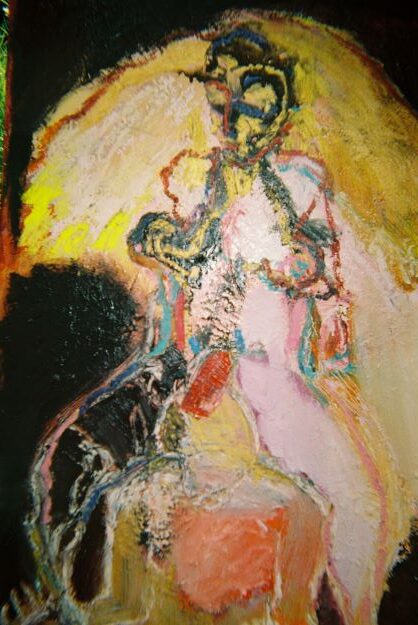









Like a matryoshka doll, artist Delpha Hudson’s paintings are composed of layers. Hudson rethinks the distant past, creating a new symbolic medievalism that she describes as a ‘productive disorientation of old narratives.’ Hudson’s historical research has shaped her current revisionist perspective. When asked what she has learned from studying previous eras, she explains that, ‘what I have realised is that the past constantly changes – we write and rewrite it based on where we are now.’

Recently, for her One+All (2022) project, Hudson has been painting food sacks at Boscawen-Ûn Stone Circle in Cornwall, built in the Bronze Age likely for communal purposes. Among the community outreach activities at the site, she hosted gatherings and distributed food bags which were donated to local food banks. In her words, ‘the project is centred around exploring politically motivated questions about care, collectivity, local networks and power structures.’
Visually, her work evokes mediaeval paradigms through intricate tableaus that chronicle cavernous narratives comparable to painter Hieronymus Bosch’s early sixteenth-century parabolic compositions. Hudson’s paintings sometimes resemble tapestries with detailed floral patterns, figural subjects, chimaeras and grotesque forms. Women and children are interlinked with mythical monstrosities and bestiaries that act as visual signposts for ambivalent domestic experience.

Although she began painting from a young age and has been working as an artist for over twenty years, her background in History and Performance led her to painting almost in secret. ‘I’ve always painted, but when I studied art in the nineties, I wanted to make politically motivated work and painting just wasn’t then,’ she explained, ‘I worked with performance, film, and installation. Each of these things still go into the pot when I paint.’
Her current practice is influenced by the twentieth-century Russian philosopher Mikhail Bakhtin and his literary mode of the carnivalesque. The carnivalesque is a tool for subverting dominant zeitgeists and ideologies, including religion, patriarchy and hierarchy, through chaos and humour. It satirises notions of organised structures and frameworks of control within the private and public spheres, calling into question any overarching societal relativity. Hudson reframes this private-public dichotomy through her depiction of carnivalesque figures that offer alternative viewpoints on equality, selfhood and social relations.

The artist’s heterodox approach can be seen in her recent Standard Bearer (2022) painting, portraying a farcically domesticated Knight. The female warrior, whose suit of armour is contrastingly adorned with an apron, carries out mundane household chores such as mopping and dusting. This character represents how women’s bodies are impacted by control, coercion, and power, a representation of patriarchal society. Allegorical and subversive, Hudson reimagines mediaeval narratives of gender dynamics while insistently asserting her own voice. This contrast satirises the binary division of these roles that was theorised in the Victorian era and continues to exist in the 21st century.
The mixed-media work, A history of domestic appliances (2021), combines bitumen, acrylic and oil paint. This sticky petroleum substance is often found in lakes and seeps all over the world after having been formed by microscopic algae and a slew of other long-dead creatures from the Carboniferous period. During the Georgian era, bitumen surged in popularity in Britain as a paint additive. This mineral lends its rich, sombre, inky tones to artists like Joshua Reynolds, Thomas Lawrence, Henry Fuseli, who mixed it into black oil paint to enhance the depth of their portraits.


Instead of mixing bitumen into her paints, Hudson uses it as a conceptually ambivalent substance dripping it from a stick to generate sticky outlines. Bitumen provides depth in its darkness; however Hudson has recently switched to more environmentally friendly and less toxic alternatives.
Her painting Consider the lilies (2021) also incorporated this material, where a figure is closing a curtain. According to Hudson, the effect is to ‘destroy’ the decorative pattern and ‘manipulate expectations’ of beauty. The gesture of closing curtains symbolises a way to cloak anxiety. She compares this action to ‘shutting a book on an unpleasant chapter’ which may provide some temporary respite.


Meanwhile in the painting Despised and ashamed I tell you truly by them all I am condemned (2021), a thin layer of bituminous substance clothes a figure. Taking the title from the play Oresteia, composed in the fifth century BC by Aeschylus, a Greek writer often called the ‘father of tragedy,’ the quote perpetuates misogyny, specifically ‘societal condemnation’ to illicit guilt.
In this composition, Hudson emphasises the plight of women who are bound by social judgement. A loosely adorned, partially exposed body at odds with social norms is a symbol of control, coercion and power among women as well as the patriarchal expectations of humility and modesty.


It is Hudson’s social engagement and feminist stance which drives her work, noting how it has always been about visibility. Hudson bases her understanding of her subject matter on her personal experiences and those of other women, ‘especially caregivers and unpaid workers.’ She stresses the importance of ‘being seen for what you do,’ when reflecting on work that aims to be representative, create conversations about difficult topics and change the narrative to achieve greater equality for women.

Her work aims to engender empathy and understanding for women’s lived experience and create new narratives and conversations about selfhood and care. Reimagining and re-imaging the past in complex ways her work asserts conflicting and revealing perspectives on the human condition.
10.06.2022
Words by Moriah Ogunbiyi
Related
Journal


